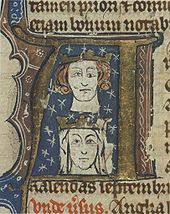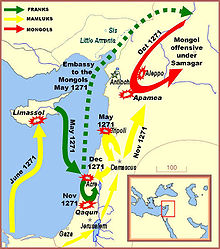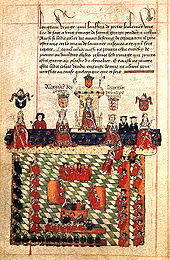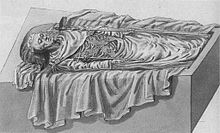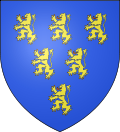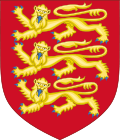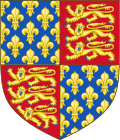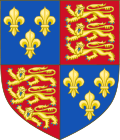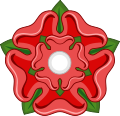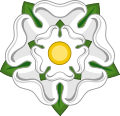- Edward I of England
-
"Edward I" redirects here. For other kings who might be known by this name, see King Edward.
Edward I Longshanks 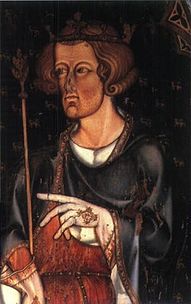
Portrait in Westminster Abbey, thought to be of Edward I King of England (more...) Reign 16 November 1272 – 7 July 1307 Coronation 19 August 1274 Predecessor Henry III Successor Edward II Spouse Eleanor of Castile
m. 1254; dec. 1290
Margaret of France
m. 1299; wid. 1307Issue Eleanor, Countess of Bar
Joan, Countess of Hertford
Alphonso, Earl of Chester
Margaret, Duchess of Brabant
Mary of Woodstock
Elizabeth, Countess of Hereford
Edward II of England
Thomas, Earl of Norfolk
Edmund, Earl of KentHouse House of Plantagenet Father Henry III of England Mother Eleanor of Provence Born 17/18 June 1239
Palace of Westminster, London, EnglandDied 7 July 1307 (aged 68)
Burgh by Sands, Cumberland, EnglandBurial Westminster Abbey, London, England Religion Roman Catholic Edward I (17 June 1239 – 7 July 1307), also known as Edward Longshanks and the Hammer of the Scots, was King of England from 1272 to 1307. The first son of Henry III, Edward was involved early in the political intrigues of his father's reign, which included an outright rebellion by the English barons. In 1259, he briefly sided with a baronial reform movement, supporting the Provisions of Oxford. After reconciliation with his father, however, he remained loyal throughout the subsequent armed conflict, known as the Second Barons' War. After the Battle of Lewes, Edward was hostage to the rebellious barons, but escaped after a few months and joined the fight against Simon de Montfort. Montfort was defeated at the Battle of Evesham in 1265, and within two years the rebellion was extinguished. With England pacified, Edward left on a crusade to the Holy Land. The crusade accomplished little, and Edward was on his way home in 1272 when he was informed that his father had died. Making a slow return, he reached England in 1274 and he was crowned king at Westminster on 19 August.
Edward's reign had two main phases. He spent the first years reforming royal administration. Through an extensive legal inquiry, Edward investigated the tenure of various feudal liberties, while the law was reformed through a series of statutes regulating criminal and property law. Increasingly, however, Edward's attention was drawn towards military affairs. After suppressing a minor rebellion in Wales in 1276–77, Edward responded to a second rebellion in 1282–83 with a full-scale war of conquest. After a successful campaign, Edward subjected Wales to English rule, built a series of castles and towns in the countryside and settled them with Englishmen. Next, his efforts were directed towards Scotland. Initially invited to arbitrate a succession dispute, Edward claimed feudal suzerainty over the kingdom. In the war that followed, the Scots persevered, even though the English seemed victorious at several points. At the same time there were problems at home. In the mid-1290s, extensive military campaigns required high levels of taxation, and Edward met with both lay and ecclesiastical opposition. These crises were initially averted, but issues remained unsettled. When the king died in 1307, he left to his son, Edward II, an ongoing war with Scotland and many financial and political problems.
Edward I was a tall man for his era, hence the nickname "Longshanks". He was temperamental, and this, along with his height, made him an intimidating man, and he often instilled fear in his contemporaries. Nevertheless, he held the respect of his subjects for the way he embodied the medieval ideal of kingship, as a soldier, an administrator and a man of faith. Modern historians have been more divided on their assessment of the king; while some have praised him for his contribution to the law and administration, others have criticised him for his uncompromising attitude to his nobility. Currently, Edward I is credited with many accomplishments during his reign, including restoring royal authority after the reign of Henry III, establishing parliament as a permanent institution and thereby also a functional system for raising taxes, and reforming the law through statutes. At the same time, he is also often criticised for other actions, such as his brutal conduct towards the Scots, and issuing the Edict of Expulsion in 1290, by which the Jews were expelled from England. The Edict remained in effect for the rest of the Middle Ages, and it would be over 350 years until it was formally overturned in 1656.
Contents
Early years
Childhood and marriage
Edward was born at the Palace of Westminster on the night of 17–18 June 1239, to King Henry III and Eleanor of Provence.[2] Although the young prince was seriously ill on several occasions, in 1246, 1247, and 1251, he grew up to be strong and healthy.[3] Edward was in the care of Hugh Giffard — father of the future Chancellor Godfrey Giffard — until Bartholomew Pecche took over at Giffard's death in 1246.[4] Among his childhood friends was his cousin Henry of Almain, son of King Henry's brother Richard of Cornwall.[3] Henry of Almain would remain a close companion of the prince, both through the civil war that followed, and later during the crusade.[5]
In 1254, English fears of a Castilian invasion of the English province of Gascony induced Edward's father to arrange a politically expedient marriage between his fourteen-year-old son and Eleanor, the half-sister of King Alfonso X of Castile.[6] Eleanor and Edward were married on 1 November 1254 in the Abbey of Santa María la Real de Las Huelgas in Castile.[7] As part of the marriage agreement, the young prince received grants of land worth 15,000 marks a year.[8] Though the endowments King Henry made were sizeable, they offered Edward little independence. He had already received Gascony as early as 1249, but Simon de Montfort, 6th Earl of Leicester, had been appointed as royal lieutenant the year before and, consequently, drew its income, so in practice Edward derived neither authority nor revenue from this province.[9] The grant he received in 1254 included most of Ireland, and much land in Wales and England, including the earldom of Chester, but the king retained much control over the land in question, particularly in Ireland, so Edward's power was limited there as well, and the king derived most of the income from those lands.[10]
From 1254 to 1257, Edward was under the influence of his mother's relatives, known as the Savoyards,[11] the most notable of whom was Peter of Savoy, the queen's uncle.[12] After 1257, Edward increasingly fell in with the Poitevin or Lusignan faction — the half-brothers of his father Henry III — led by such men as William de Valence.[13] This association was significant, because the two groups of privileged foreigners were resented by the established English aristocracy, and they would be at the centre of the ensuing years' baronial reform movement.[14] There were tales of unruly and violent conduct by Edward and his Lusignan kinsmen, which raised questions about the royal heir's personal qualities. The next years would be formative on Edward's character.[15]
Early ambitions
Edward had shown independence in political matters as early as 1255, when he sided with the Soler family in Gascony, in the ongoing conflict between the Soler and Colomb families. This ran contrary to his father's policy of mediation between the local factions.[16] In May 1258, a group of magnates drew up a document for reform of the king’s government — the so-called Provisions of Oxford — largely directed against the Lusignans. Edward stood by his political allies and strongly opposed the Provisions. The reform movement succeeded in limiting the Lusignan influence, however, and gradually Edward’s attitude started to change. In March 1259, he entered into a formal alliance with one of the main reformers, Richard de Clare, Earl of Gloucester. Then, on 15 October 1259, he announced that he supported the barons' goals, and their leader, Simon de Montfort.[17]
The motive behind Edward's change of heart could have been purely pragmatic; Montfort was in a good position to support his cause in Gascony.[18] When the king left for France in November, Edward's behaviour turned into pure insubordination. He made several appointments to advance the cause of the reformers, causing his father to believe that his son was considering a coup d'état.[19] When the king returned from France, he initially refused to see his son, but through the mediation of the Earl of Cornwall and the archbishop of Canterbury, the two were eventually reconciled.[20] Edward was sent abroad, and in November 1260 he again united with the Lusignans, who had been exiled to France.[21]
Back in England, early in 1262, Edward fell out with some of his former Lusignan allies over financial matters. The next year, King Henry sent him on a campaign in Wales against Llywelyn ap Gruffudd, with only limited results.[22] Around the same time, Simon de Montfort, who had been out of the country since 1261, returned to England and reignited the baronial reform movement.[23] It was at this pivotal moment, as the king seemed ready to resign to the barons' demands, that Edward began to take control of the situation. Whereas he had so far been unpredictable and equivocating, from this point on he remained firmly devoted to protecting his father's royal rights.[24] He reunited with some of the men he had alienated the year before — among them his childhood friend, Henry of Almain, and John de Warenne, Earl of Surrey — and retook Windsor Castle from the rebels.[25] Through the arbitration of King Louis IX of France, an agreement was made between the two parties. This so-called Mise of Amiens was largely favourable to the royalist side, and laid the seeds for further conflict.[26]
Civil war
Main article: Second Barons' WarThe years 1264–1267 saw the conflict known as the Second Barons' War, in which baronial forces led by Simon de Montfort fought against those who remained loyal to the king.[27] The first scene of battle was the city of Gloucester, which Edward managed to retake from the enemy. When Robert de Ferrers, earl of Derby, came to the assistance of the rebels, Edward negotiated a truce with the earl, the terms of which he later broke. Edward then captured Northampton from Montfort's son Simon, before embarking on a retaliatory campaign against Derby's lands.[28] The baronial and royalist forces finally met at the Battle of Lewes, on 14 May 1264. Edward, commanding the right wing, performed well, and soon defeated the London contingent of Montfort's forces. Unwisely, however, he followed the scattered enemy in pursuit, and on his return found the rest of the royal army defeated.[29] By the agreement known as the Mise of Lewes, Edward and his cousin Henry of Almain were given up as prisoners to Montfort.[30]
Edward remained in captivity until March, and even after his release he was kept under strict surveillance.[31] Then, on 28 May, he managed to escape his custodians and joined up with the Earl of Gloucester, who had recently defected to the king's side.[32] Montfort's support was now dwindling, and Edward retook Worcester and Gloucester with relatively little effort.[33] Meanwhile, Montfort had made an alliance with Llywelyn and started moving east to join forces with his son Simon. Edward managed to make a surprise attack at Kenilworth Castle, where the younger Montfort was quartered, before moving on to cut off the earl of Leicester.[34] The two forces then met at the second great encounter of the Barons' War — the Battle of Evesham, on 4 August 1265. Montfort stood little chance against the superior royal forces, and after his defeat he was killed and mutilated on the field.[35]
Through such episodes as the deception of Derby at Gloucester, Edward acquired a reputation as untrustworthy. During the summer campaign, though, he began to learn from his mistakes, and acted in a way that gained the respect and admiration of his contemporaries.[36] The war did not end with Montfort's death, and Edward participated in the continued campaigning. At Christmas, he came to terms with the younger Simon de Montfort and his associates at the Isle of Axholme in Lincolnshire, and in March he led a successful assault on the Cinque Ports.[37] A contingent of rebels held out in the virtually impregnable Kenilworth Castle and did not surrender until the drafting of the conciliatory Dictum of Kenilworth.[38] In April it seemed as if Gloucester would take up the cause of the reform movement, and civil war would resume, but after a renegotiation of the terms of the Dictum of Kenilworth, the parties came f.[39] Edward, however, was little involved in the settlement negotiations following the wars; at this point his main focus was on planning his upcoming crusade.[40]
Crusade and accession
See also: Eighth Crusade and Ninth CrusadeEdward took the crusader's cross in an elaborate ceremony on 24 June 1268, with his brother Edmund and cousin Henry of Almain. Among others who committed themselves to the Ninth Crusade were Edward's former adversaries—like the earl of Gloucester, though the earl did not ultimately participate.[41] With the country pacified, the greatest impediment to the project was providing sufficient finances.[42] King Louis IX of France, who was the leader of the crusade, provided a loan of about £17,500.[43] This, however, was not enough; the rest had to be raised through a tax on the laity, which had not been levied since 1237.[43] In May 1270, Parliament granted a tax of a twentieth,[44] in exchange for which the king agreed to reconfirm Magna Carta, and to impose restrictions on Jewish money lending.[45] On 20 August Edward sailed from Dover for France.[46] Historians have not determined the size of the force with any certainty, but Edward probably brought with him around 225 knights and all together less than 1000 men.[42]
Originally, the Crusaders intended to relieve the beleaguered Christian stronghold of Acre, but Louis had been diverted to Tunis. The French king and his brother Charles of Anjou, who had made himself king of Sicily, decided to attack the emirate to establish a stronghold in North Africa.[47] The plans failed when the French forces were struck by an epidemic which, on 25 August, took the life of King Louis himself.[48] By the time Edward arrived at Tunis, Charles had already signed a treaty with the emir, and there was little else to do but return to Sicily. The crusade was postponed until next spring, but a devastating storm off the coast of Sicily dissuaded Charles of Anjou and Louis's successor Philip III from any further campaigning.[49] Edward decided to continue alone, and on 9 May 1271 he finally landed at Acre.[50]
By then, the situation in the Holy Land was a precarious one. Jerusalem had fallen in 1244, and Acre was now the centre of the Christian state.[51] The Muslim states were on the offensive under the Mamluk leadership of Baibars, and were now threatening Acre itself. Though Edward's men were an important addition to the garrison, they stood little chance against Baibars' superior forces, and an initial raid at nearby St Georges-de-Lebeyne in June was largely futile.[52] An embassy to the Mongols helped bring about an attack on Aleppo in the north, which helped to distract Baibar's forces.[53] In November, Edward led a raid on Qaqun, which could have served as a bridgehead to Jerusalem, but both the Mongol invasion and the attack on Qaqun failed. Things now seemed increasingly desperate, and in May 1272 Hugh III of Cyprus, who was the nominal king of Jerusalem, signed a ten–year truce with Baibars.[54] Edward was initially defiant, but an attack by a Muslim assassin in June forced him to abandon any further campaigning. Although he managed to kill the assassin, he was struck in the arm by a dagger feared to be poisoned, and became severely weakened over the following months.[55]
It was not until 24 September that Edward left Acre. Arriving in Sicily, he was met with the news that his father had died on 16 November.[56] Edward was deeply saddened by this news, but rather than hurrying home at once, he made a leisurely journey northwards. This was partly due to his health still being poor, but also due to a lack of urgency.[57] The political situation in England was stable after the mid-century upheavals, and Edward was proclaimed king at his father's death, rather than at his own coronation, as had until then been customary.[58] In Edward's absence, the country was governed by a royal council, led by Robert Burnell.[59] The new king embarked on an overland journey through Italy and France, where among other things he visited the pope in Rome and suppressed a rebellion in Gascony.[60] Only on 2 August 1274 did he return to England, and was crowned on 19 August.[61]
Reign
Administration and the law
 Groat of Edward I (4 pence)
Groat of Edward I (4 pence)
Upon returning home, Edward immediately embarked on the administrative business of the nation, and his major concern was restoring order and re-establishing royal authority after the disastrous reign of his father.[62] To accomplish this, he immediately ordered an extensive change of administrative personnel. The most important of these was the appointment of Robert Burnell as chancellor, a man who would remain in the post until 1292 as one of the king's closest associates.[63] Edward then replaced most local officials, such as the escheators and sheriffs.[64] This last measure was done in preparation for an extensive inquest covering all of England, that would hear complaints about abuse of power by royal officers. The inquest produced the set of so-called Hundred Rolls, from the administrative subdivision of the hundred.[65]
The second purpose of the inquest was to establish what land and rights the crown had lost during the reign of Henry III.[66]
The Hundred Rolls formed the basis for the later legal inquiries called the Quo warranto proceedings. The purpose of these inquiries was to establish by what warrant (Latin: Quo warranto) various liberties were held.[67] If the defendant could not produce a royal licence to prove the grant of the liberty, then it was the crown's opinion – based on the writings of the influential thirteenth-century legal scholar Bracton – that the liberty should revert to the king.
By enacting the Statute of Gloucester in 1278 the king challenged baronial rights through a revival of the system of general eyres (royal justices to go on tour throughout the land) and through a significant increase in the number of pleas of quo warranto to be heard by such eyres.
This caused great consternation among the aristocracy, who insisted that long use in itself constituted license.[68] A compromise was eventually reached in 1290, whereby a liberty was considered legitimate as long as it could be shown to have been exercised since the coronation of King Richard I, in 1189.[69] Royal gains from the Quo warranto proceedings were insignificant; few liberties were returned to the king.[70] Edward had nevertheless won a significant victory, in clearly establishing the principle that all liberties essentially emanated from the crown.[71]
The 1290 statute of Quo warranto was only one part of a wider legislative effort, which was one of the most important contributions of Edward I's reign.[3] This era of legislative action had started already at the time of the baronial reform movement; the Statute of Marlborough (1267) contained elements both of the Provisions of Oxford and the Dictum of Kenilworth.[72] The compilation of the Hundred Rolls was followed shortly after by the issue of Westminster I (1275), which asserted the royal prerogative and outlined restrictions on liberties.[73] In the Mortmain (1279), the issue was grants of land to the church.[74] The first clause of Westminster II (1285), known as De donis conditionalibus, dealt with family settlement of land, and entails.[75] Merchants (1285) established firm rules for the recovery of debts,[76] while Winchester (1285) dealt with peacekeeping on a local level.[77] Quia emptores (1290) – issued along with Quo warranto – set out to remedy land ownership disputes resulting from alienation of land by subinfeudation.[78] The age of the great statutes largely ended with the death of Robert Burnell in 1292.[79]
Welsh wars
Llywelyn ap Gruffudd enjoyed an advantageous situation in the aftermath of the Barons' War. Through the 1267 Treaty of Montgomery, he officially obtained land he had conquered in the Four Cantrefs of Perfeddwlad and was recognised in his title of Prince of Wales.[80][81] Armed conflicts nevertheless continued, in particular with certain dissatisfied Marcher Lords, such as the earl of Gloucester, Roger Mortimer and Humphrey de Bohun, Earl of Hereford.[82] Problems were exacerbated when Llywelyn's younger brother Dafydd and Gruffydd ap Gwenwynwyn of Powys, after failing in an assassination attempt against Llywelyn, defected to the English in 1274.[83] Citing ongoing hostilities and the English king's harbouring of his enemies, Llywelyn refused to do homage to Edward.[84] For Edward, a further provocation came from Llywelyn's planned marriage to Eleanor, daughter of Simon de Montfort.[85] In November 1276, war was declared.[86] Initial operations were launched under the captaincy of Mortimer, Lancaster (Edward's brother Edmund) and William de Beauchamp, Earl of Warwick.[87] Support for Llywelyn was weak among his own countrymen.[88] In July 1277 Edward invaded with a force of 15,500 — of whom 9,000 were Welshmen.[89] The campaign never came to a major battle, and Llywelyn soon realised he had no choice but to surrender.[89] By the Treaty of Aberconwy in November 1277, he was left only with the land of Gwynedd, though he was allowed to retain the title of Prince of Wales.[90]
When war broke out again in 1282, it was an entirely different undertaking. For the Welsh, this war was over national identity, enjoying wide support, provoked particularly by attempts to impose English law on Welsh subjects.[91] For Edward, it became a war of conquest rather than simply a punitive expedition, like the former campaign.[92] The war started with a rebellion by Dafydd, who was discontented with the reward he had received from Edward in 1277.[93] Llywelyn and other Welsh chieftains soon joined in, and initially the Welsh experienced military success. In June, Gloucester was defeated at the Battle of Llandeilo Fawr.[94] On 6 November, while John Peckham, archbishop of Canterbury, was conducting peace negotiations, Edward's commander of Anglesey, Luke de Tany, decided to carry out a surprise attack. A pontoon bridge had been built to the mainland, but shortly after Tany and his men crossed over, they were ambushed by the Welsh and suffered heavy losses at the Battle of Moel-y-don.[95] The Welsh advances ended on 11 December, however, when Llywelyn was lured into a trap and killed at the Battle of Orewin Bridge.[96] The conquest of Gwynedd was complete with the capture in June 1283 of Dafydd, who was taken to Shrewsbury and executed as a traitor the following autumn.[97]
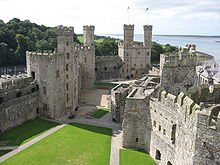 Caernarfon Castle, one of the most imposing of Edward's Welsh castles.
Caernarfon Castle, one of the most imposing of Edward's Welsh castles.
Further rebellions occurred in 1287–8 and, more seriously, in 1294 — with five under Madog ap Llywelyn, a distant relative of Llywelyn ap Gruffudd. This last conflict demanded the king's own attention, but in both cases the rebellions were put down.[3] By the 1284 Statute of Rhuddlan, the Principality of Wales was incorporated into England and was given an administrative system like the English, with counties policed by sheriffs.[98] English law was introduced in criminal cases, though the Welsh were allowed to maintain their own customary laws in some cases of property disputes.[99] After 1277, and increasingly after 1283, Edward embarked on a full-scale project of English settlement of Wales, creating new towns like Flint, Aberystwyth, and Rhuddlan.[100] An extensive project of castle-building was also initiated. The assignment was given to Master James of Saint George, a prestigious architect whom Edward had met in Savoy on his return from the crusade. Among the major buildings were the castles of Beaumaris, Caernarfon, Conwy and Harlech.[101] His programme of castle building in Wales heralded the introduction of the widespread use of arrowslits in castle walls across Europe, drawing on Eastern influences.[102] Also a product of the Crusades was the introduction of the concentric castle, and four of the eight castles Edward founded in Wales followed this design.[103][104] In 1284, King Edward's son Edward — the later Edward II — was born at Caernarfon Castle. In 1301 at Lincoln, the young Edward became the first English prince to be invested with the title of Prince of Wales.[105][106]
Diplomacy and war on the Continent
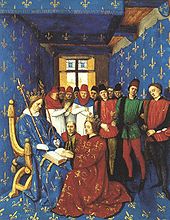 Homage of Edward I (kneeling) to Philip IV (seated). As Duke of Aquitaine, Edward was a vassal of the French king.
Homage of Edward I (kneeling) to Philip IV (seated). As Duke of Aquitaine, Edward was a vassal of the French king.
Edward never again went on crusade after his return to England in 1274, but he maintained an intention to do so, and took the cross again in 1287.[107] This intention guided much of his foreign policy, until at least 1291. To stage a European-wide crusade, it was essential to prevent conflict between the greater princes on the continent. A major obstacle to this was represented by the conflict between the French House of Anjou ruling southern Italy, and the kingdom of Aragon in Spain. In 1282, the citizens of Palermo rose up against Charles of Anjou and turned for help to Peter of Aragon, in what has become known as the Sicilian Vespers. In the war that followed, Charles of Anjou's son, Charles of Salerno, was taken prisoner by the Aragonese.[108] The French began planning an attack on Aragon, raising the prospect of a large-scale European war. To Edward, it was imperative that such a war be avoided, and in Paris in 1286 he brokered a truce between France and Aragon that helped secure Charles' release.[109] As far as the crusades were concerned, however, Edward's efforts proved ineffective. A devastating blow to his plans came in 1291, when the Mamluks captured Acre, the last Christian stronghold in the Holy Land.[110]
After the fall of Acre, Edward's international role changed from that of a diplomat to an antagonist. He had long been deeply involved in the affairs of his own Duchy of Gascony. In 1278 he assigned an investigating commission to his trusted associates Otto de Grandson and the chancellor Robert Burnell, which caused the replacement of the seneschal Luke de Tany.[111] In 1286, Edward visited the region himself and stayed for almost three years.[112] The perennial problem, however, was the status of Gascony within the kingdom of France, and Edward's role as the French king's vassal. On his diplomatic mission in 1286, Edward had paid homage to the new king, Philip IV, but in 1294 Philip declared Gascony forfeit when Edward refused to appear before him in Paris to discuss the recent conflict between English, Gascon, and French sailors (that had resulted in several French ships being captured, along with the sacking of the French port of La Rochelle).[113]
In the war that followed, Edward planned for a two-pronged attack. While the English forces focused on Gascony, alliances were made with the princes of the Low Countries, Germany, and Burgundy, who would attack France from the north.[3] The alliances proved volatile, however, and Edward was facing trouble at home at the time, both in Wales and Scotland. It was not until August 1297 that he was finally able to sail for Flanders, at which time his allies there had already suffered defeat.[114] The support from Germany never materialised, and Edward was forced to seek peace. His marriage to the French princess Margaret, Philip IV's half-sister and his own first cousin once removed, in 1299 ended the war, but the whole affair had proven both costly and fruitless for the English.[115]
The Great Cause
See also: Competitors for the Crown of ScotlandThe relationship between the nations of England and Scotland by the 1280s was one of relatively harmonious coexistence.[116] The issue of homage did not reach the same level of controversy as it did in Wales; in 1278 King Alexander III of Scotland paid homage to Edward I, but apparently only for the lands he held of Edward in England.[117] Problems arose only with the Scottish succession crisis of the early 1290s. In the years from 1281 to 1284, Alexander's two sons and one daughter died in quick succession. Then, in 1286, King Alexander died himself, leaving as heir to the throne of Scotland the three-year-old Margaret, the Maid of Norway, who was born in 1283 to Alexander's daughter Margaret and King Eric II of Norway.[118] By the Treaty of Birgham, it was agreed that Margaret should marry King Edward's then one-year-old son Edward of Carnarvon, though Scotland would remain free of English overlordship.[119][120]
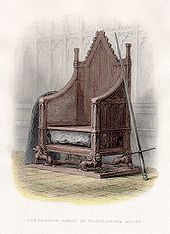 19th-century drawing of the Stone of Destiny. The Scottish coronation stone remained at Westminster until it was returned to Scotland in 1996.
19th-century drawing of the Stone of Destiny. The Scottish coronation stone remained at Westminster until it was returned to Scotland in 1996.
Margaret, by now seven years of age, sailed from Norway for Scotland in the autumn of 1290, but fell ill on the way and died in Orkney.[121][122] This left the country without an obvious heir, and led to the succession dispute known to history as the Great Cause.[123] Even though as many as fourteen claimants put forward their claims to the title, the real contest was between John Balliol and Robert de Brus.[124] The Scottish magnates made a request to Edward to arbitrate in the dispute.[125] At Birgham, with the prospect of a personal union between the two realms, the question of suzerainty had not been of great importance to Edward. Now he insisted that, if he were to settle the contest, he had to be fully recognised as Scotland's feudal overlord.[126] The Scots were reluctant to make such a concession, and replied that since the country had no king, no one had the authority to make this decision.[127] This problem was circumvented when the competitors agreed that the realm would be handed over to Edward until a rightful heir had been found.[128] After a lengthy hearing, a decision was made in favour of John Balliol on 17 November 1292.[129]
Even after Balliol's accession, Edward still continued to assert his authority over Scotland. Against the objections of the Scots, he agreed to hear appeals on cases ruled on by the court of guardians that had governed Scotland during the interregnum.[130] A further provocation came in a case brought by Macduff, son of Malcolm, Earl of Fife, in which Edward demanded that Balliol appear in person before the English Parliament to answer the charges.[131] This the Scottish king did, but the final straw was Edward's demand that the Scottish magnates provide military service in the war against France.[132] This was unacceptable; the Scots instead formed an alliance with France and launched an unsuccessful attack on Carlisle.[133] Edward responded by invading Scotland in 1296 and taking the town of Berwick in a particularly bloody attack.[134] At the Battle of Dunbar, Scottish resistance was effectively crushed.[135] Edward confiscated the Stone of Destiny – the Scottish coronation stone – and brought it to Westminster, deposed Balliol and placed him in the Tower of London, and installed Englishmen to govern the country.[3] The campaign had been very successful, but the English triumph would only be temporary.[136]
Finances, Parliament and the Expulsion of Jews
Edward I's frequent military campaigns put a great financial strain on the nation.[137] There were several ways through which the king could raise money for war, including customs duties, money lending and lay subsidies. In 1275, Edward I negotiated an agreement with the domestic merchant community that secured a permanent duty on wool. In 1303, a similar agreement was reached with foreign merchants, in return for certain rights and privileges.[138] The revenues from the customs duty were handled by the Riccardi, a group of bankers from Lucca in Italy.[139] This was in return for their service as money lenders to the crown, which helped finance the Welsh Wars. When the war with France broke out, the French king confiscated the Riccardi's assets, and the bank went bankrupt.[140] After this, the Frescobaldi of Florence took over the role as money lenders to the English crown.[141]
16th-century illustration of Edward I presiding over Parliament. The scene shows Alexander III of Scotland and Llywelyn ap Gruffudd of Wales on either side of Edward; an episode that never actually occurred.[142]
Another source of crown income was represented by England's Jews. The Jews were the king's personal property, and he was free to tax them at will.[143] By 1280, the Jews had been exploited to a level at which they were no longer of much financial use to the crown, but they could still be used in political bargaining.[144] Their usury business – a practice forbidden to Christians – had made many people indebted to them and caused general popular resentment.[145] In 1275, Edward had issued the Statute of the Jewry, which outlawed usury and encouraged the Jews to take up other professions;[146] in 1279, in the context of a crack-down on coin-clippers, he arrested all the heads of Jewish households in England and had around 300 of them executed.[147] In 1280, he ordered all Jews to attend special sermons, preached by Dominican friars, with the hope of persuading them to convert, but these exhortations were not followed.[148] The final attack on the Jews in England came in the Edict of Expulsion in 1290, whereby Edward formally expelled all Jews from England.[149] This not only generated revenues through royal appropriation of Jewish loans and property, but it also gave Edward the political capital to negotiate a substantial lay subsidy in the 1290 Parliament.[150] The expulsion, which was not reversed until 1656,[151] followed a precedent set by other European territorial princes: Philip II of France had expelled all Jews from his own lands in 1182; John I, Duke of Brittany, drove them out of his duchy in 1239; and in the late 1240s Louis IX of France had expelled the Jews from the royal demesne before his first passage to the East.[152]
Among the main achievements of the reign of Edward I were the reforms of the institution of the English Parliament and its transformation into a source for generating revenues.[3] Edward held Parliament at a reasonably regular basis throughout his reign.[153] In 1295, however, a significant change occurred. For this Parliament, in addition to the secular and ecclesiastical lords, two knights from each county and two representatives from each borough were summoned.[154] The representation of commons in Parliament was nothing new; what was new was the authority under which these representatives were summoned. Whereas previously the commons had been expected simply to assent to decisions already made by the magnates, it was now proclaimed that they should meet with the full authority (plena potestas) of their communities, to give assent to decisions made in Parliament.[155] The king now had full backing for collecting lay subsidies from the entire population. Lay subsidies were taxes collected at a certain fraction of the moveable property of all laymen.[156] Whereas Henry III had only collected four of these in his reign, Edward I collected nine.[157] This format eventually became the standard for later Parliaments, and historians have named the assembly the "Model Parliament".[158]
Constitutional crisis
The incessant warfare of the 1290s put a great financial demand on Edward's subjects. Whereas the king had only levied three lay subsidies until 1294, four such taxes were granted in the years 1294–97, raising over £200,000.[159] Along with this came the burden of prises (appropriation of food), seizure of wool and hides, and the unpopular additional duty on wool, dubbed the maltolt.[160] The fiscal demands on the king's subjects caused resentment, and this resentment eventually led to serious political opposition. The initial resistance was not caused by the lay taxes, however, but by clerical subsidies. In 1294, Edward made a demand of a grant of one half of all clerical revenues. There was some resistance, but the king responded by threatening with outlawry, and the grant was eventually made.[161] At the time, the archbishopric of Canterbury was vacant, since Robert Winchelsey was in Italy to receive consecration.[162] Winchelsey returned in January 1295 and had to consent to another grant in November of that year. In 1296, however, his position changed when he received the papal bull Clericis laicos. This bull prohibited the clergy from paying taxes to lay authorities without explicit consent from the Pope.[163] When the clergy, with reference to the bull, refused to pay, Edward responded with outlawry.[164] Winchelsey was presented with a dilemma between loyalty to the king and upholding the papal bull, and he responded by leaving it to every individual clergyman to pay as he saw fit.[165] By the end of the year, a solution was offered by the new papal bull Etsi de statu, which allowed clerical taxation in cases of pressing urgency.[166]
Edward
By God, Sir Earl, either go or hang
Roger Bigod
By that same oath, O king, I shall neither go nor hangChronicle of Walter of Guisborough[167]Opposition from the laity took longer to surface. This resistance focused on two things: the king's right to demand military service, and his right to levy taxes. At the Salisbury parliament of February 1297, Roger Bigod, Earl of Norfolk, in his capacity as Marshal of England, objected to a royal summons of military service. Bigod argued that the military obligation only extended to service alongside the king; if the king intended to sail to Flanders, he could not send his subjects to Gascony.[168] In July, Bigod and Humphrey de Bohun, Earl of Hereford and Constable of England, drew up a series of complaints known as the Remonstrances, in which objections to the extortionate level of taxation were voiced.[169] Undeterred, Edward requested another lay subsidy. This one was particularly provocative, because the king had sought consent only from a small group of magnates, rather than from representatives from the communities in parliament.[170] While Edward was in Winchelsea, preparing for the campaign in Flanders, Bigod and Bohun turned up at the Exchequer to prevent the collection of the tax.[171] As the king left the country with a greatly reduced force, the kingdom seemed to be on the verge of civil war.[172][173] What resolved the situation was the English defeat by the Scots at the Battle of Stirling Bridge. The renewed threat to the homeland gave king and magnates common cause.[174] Edward signed the Confirmatio cartarum – a confirmation of Magna Carta and its accompanying Charter of the Forest – and the nobility agreed to serve with the king on a campaign in Scotland.[175]
Edward's problems with the opposition did not end with the Falkirk campaign. Over the following years he would be held up to the promises he had made, in particular that of upholding the Charter of the Forest.[176] In the parliament of 1301, the king was forced to order an assessment of the royal forests, but in 1305 he obtained a papal bull that freed him from this concession.[177] Ultimately, it was a failure in personnel that spelt the end of the opposition against Edward I. Bohun died late in 1298, after returning from the Falkirk campaign.[178] As for Bigod, in 1302 he arrived at an agreement with the king that was beneficial for both: Bigod, who had no children, made Edward his heir, in return for a generous annual grant.[179] Edward finally got his revenge on Winchelsey in 1305, when Clement V was elected pope. Clement was a Gascon sympathetic to the king, and on Edward's instigation had Winchelsey suspended from office.[180]
Final years: return to Scotland
See also: First Scottish War of Independence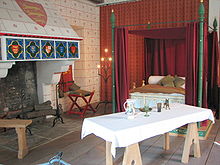 Reconstruction of Edward I's private chambers at the Tower of London
Reconstruction of Edward I's private chambers at the Tower of London
The situation in Scotland had seemed resolved when Edward left the country in 1296, but resistance soon emerged under the leadership of the strategically gifted and charismatic William Wallace. On 11 September 1297, a large English force under the leadership of John de Warenne, Earl of Surrey, and Hugh de Cressingham was routed by a much smaller Scottish army led by Wallace and Andrew Moray at Stirling Bridge.[181] The defeat sent shockwaves into England, and preparations for a retaliatory campaign started immediately. Soon after Edward returned from Flanders, he headed north.[182] On 22 July 1298, in the only major battle he had fought since Evesham in 1265, Edward defeated Wallace's forces at the Battle of Falkirk.[183] Edward, however, was not able to take advantage of the momentum, and the next year the Scots managed to recapture Stirling Castle.[184] Even though Edward campaigned in Scotland both in 1300 and 1301, the Scots refused to engage in open battle again, preferring instead to raid the English countryside in smaller groups.[185] The English managed to subdue the country by other means, however. In 1303, a peace agreement was reached between England and France, effectively breaking up the Franco-Scottish alliance.[186] Robert the Bruce, the grandson of the claimant to the crown in 1291, had sided with the English in the winter of 1301–02.[187] By 1304, most of the other nobles of the country had also pledged their allegiance to Edward, and this year the English also managed to re-take Stirling Castle.[188] A great propaganda victory was achieved in 1305 when Wallace was betrayed by Sir John de Menteith and turned over to the English, who had him taken to London where he was publicly executed.[189] With Scotland largely under English control, Edward installed Englishmen and collaborating Scots to govern the country.[190]
The situation changed again on 10 February 1306, when Robert the Bruce murdered his rival John Comyn and a few weeks later, on 25 March, had himself crowned king of Scotland by Isobel, sister of the Earl of Buchan.[191] Bruce now embarked on a campaign to restore Scottish independence, and this campaign took the English by surprise.[192] Edward was suffering ill health by this time, and instead of leading an expedition himself, he gave different military commands to Aymer de Valence and Henry Percy, while the main royal army was led by the Prince of Wales.[193] The English initially met with success; on 19 June, Aymer de Valence routed Bruce at the Battle of Methven.[194] Bruce was forced into hiding, while the English forces recaptured their lost territory and castles.[195] Edward responded with severe brutality against Bruce's allies; it was clear that he now regarded the struggle not as a war between two nations, but as the suppression of a rebellion of disloyal subjects.[196] This brutality, though, rather than helping to subdue the Scots, had the opposite effect, and rallied growing support for Bruce.[197] In February Bruce reappeared and started gathering men, and in May he defeated Aymer de Valence at the Battle of Loudoun Hill.[198] Edward, who had rallied somewhat, now moved north himself. On the way, however, he developed dysentery, and his condition deteriorated. On 6 July he encamped at Burgh by Sands, just south of the Scottish border. When his servants came the next morning to lift him up so that he could eat, he died in their arms.[199]
Various stories emerged about Edward’s deathbed wishes; according to one tradition, he requested that his heart be carried to the Holy Land, along with an army to fight the infidels. A more dubious story tells of how he wished for his bones be carried along on future expeditions against the Scots. Another account of his deathbed scene is more credible; according to one chronicle, Edward gathered around him the earls of Lincoln and Warwick, Aymer de Valence, and Robert Clifford, and charged them with looking after his son Edward. In particular they should make sure that Piers Gaveston was not allowed to return to the country.[200] This wish, however, the son ignored, and had his favourite recalled from exile almost immediately.[201] Edward I's body was brought south, and after a lengthy vigil he was buried in Westminster Abbey on 27 October. The new king, Edward II, remained in the north until August, but then abandoned the campaign and headed south.[202] He was crowned king on 25 February 1308.[203]
Character and assessment
Physically, Edward was an imposing man; at 6 feet 2 inches he towered over most of his contemporaries, and hence perhaps his epithet "longshanks". He also had a reputation for a fierce temper, and he could be intimidating; one story tells of how the Dean of St Paul's, wishing to confront Edward over the high level of taxation in 1295, fell down and died once he was in the king's presence.[204] When Edward of Caernarfon demanded an earldom for his favourite Gaveston, the king erupted in anger and supposedly tore out handfuls of his son's hair.[205] Some of his contemporaries considered Edward frightening, particularly in his early days. The Song of Lewes in 1264 described him as a leopard, an animal regarded as particularly powerful and unpredictable.[206] Despite these frightening character traits, however, Edward's contemporaries considered him an able, even an ideal, king.[207] Though not loved by his subjects, he was feared and respected.[208] He met contemporary expectations of kingship in his role as an able, determined soldier and in his embodiment of shared chivalric ideals.[209] In religious observance he also fulfilled the expectations of his age: he attended chapel regularly and gave alms generously.[3]
Bishop William Stubbs, in his Constitutional History (1873–78), emphasised Edward I's contribution to the English constitution.
Modern historians have been more divided in their view of Edward I. Bishop William Stubbs, working in the whig tradition of historical writing, praised Edward as a king deliberately working towards the goal of a constitutional government. "...the self-regulating action of the body politic", according to Stubbs "was very much the work of Edward."[210] Stubbs' student T. F. Tout departed from this view. In Tout's opinion, "Even the parliamentary system grew up in obedience to the royal will. It was no yielding to a people crying for liberty, but the shrewd device of an autocrat, anxious to use the mass of the people as a check upon his hereditary foes among the greater baronage."[211] F. M. Powicke offered a more positive perspective in his extensive work on Edward I in King Henry III and the Lord Edward (1947) and The Thirteenth Century (1953).[3] K. B. McFarlane, on the other hand, criticised Edward's restrictive policy towards his earls, and concluded that "…he belonged less to the future than to the past."[212]
In 1988, Michael Prestwich released what has been called "…the first scholarly study devoted exclusively to the political career of Edward I."[213] Prestwich's work, which is considered authoritative,[214] tries to assess Edward by the standards of his own age, and concludes that his reign was a great one.[215] His contributions to the development of the law, parliament and a functioning system of taxation, as well as his military exploits, stand out in particular.[216] At the same time, he left a legacy of financial difficulties, political distrust and an unresolved situation in Scotland. The roots of the disasters of the reign of Edward II can be found in the reign of Edward I.[217] Other contemporary writers have been more willing to criticise Edward for his failings, particularly his severe treatment of the Jews.[147] There is also a great difference between English and Scottish historiography on King Edward. G. W. S. Barrow, in his biography on Robert the Bruce, accused Edward of ruthlessly exploiting the leaderless state of Scotland to obtain a feudal superiority over the kingdom.[218] This view of Edward is reflected in the popular perception of the king, as can be seen in the 1995 movie Braveheart's portrayal of the king as a hard-hearted tyrant.[219]
Name and epithets
Edward, being an Anglo-Saxon name, was not a common name among the aristocracy of England after the Norman Conquest. Henry III was devoted to the veneration of Edward the Confessor, and for this reason decided to name his firstborn son after the saint.[220] Though the first post-Conquest king to carry that name, Edward I was not the first English king named Edward; he was preceded by the Anglo-Saxon kings Edward the Elder, Edward the Martyr, and Edward the Confessor. Numerals, however, were not commonly used in Edward's time; the king was referred to simply as "King Edward", "King Edward, son of King Henry", or "King Edward, the first by that name after the Conquest". It was only after the succession of first his son and then his grandson – both of whom bore the same name – that "Edward I" came into common usage.[221]
The epithet under which Edward I is best known is probably "Longshanks" – meaning "long legs" or "long shins" – in reference to his tall stature. On 2 May 1774, the Society of Antiquaries opened Edward's tomb in Westminster Abbey. They reported that his body had been well preserved over the preceding 467 years, and measured the king's body to be 6 feet 2 inches (188 cm).[222] At this length, he would tower over most of his common contemporaries. [223] Another epithet applied to Edward I is "Hammer of the Scots". This comes from the Latin inscription on his tomb, which reads Edwardus Primus Scottorum Malleus hic est, 1308. Pactum Serva ("Here is Edward I, Hammer of the Scots, 1308. Keep the Vow").[224] This inscription, however, referring to his incessant campaigns against the Scots in the later years of his reign, is from a later date, probably the sixteenth century.[225] The seventeenth-century lawyer Edward Coke called Edward the "English Justinian". This was a way of highlighting the king's legislative accomplishments, by comparing him to the renowned Byzantine law-maker Justinian I. Unlike Justinian, Edward did not codify the law, but as William Stubbs pointed out, "if it be meant to denote the importance and permanence of his legislation and the dignity of his position in legal history", the comparison is still a valid one.[226]
Issue
 Edward I of England
Edward I of England
 Eleanor Castile
Eleanor Castile
Eleanor of Castile died on 28 November 1290. Uncommon for such marriages of the period, the couple loved each other. Moreover like his father, Edward was very devoted to his queen and was faithful to her throughout their married lives—a rarity among monarchs of the time. He was deeply affected by her death. He displayed his grief by erecting twelve so-called Eleanor crosses, one at each place where her funeral cortège stopped for the night.[227] As part of the peace accord between England and France in 1294, it was agreed that Edward should marry the French princess Margaret. The marriage took place in 1299.[228]
Edward and Eleanor had at least fourteen children, perhaps as many as sixteen. Of these, five daughters survived into adulthood, but only one boy outlived Edward – the future King Edward II. Edward I was reportedly concerned with his son's failure to live up to the expectations of an heir to the crown, and at one point decided to exile the prince's favourite Piers Gaveston.[229] Edward may have been aware of his son's bisexual orientation even though he did not throw the prince's favourite from the castle battlements as depicted in Braveheart.
By Margaret, Edward had two sons, both of whom lived into adulthood, and a daughter who died as a child.[230] The Hailes Abbey chronicle indicates that John Botetourt may have been Edward's illegitimate son, however the claim is unsubstantiated.[231]
Children by Eleanor of Castile Name Birth Death Notes Daughter 1255 1255 Stillborn or died shortly after birth Katherine 1261/63 5 Sept. 1264 Buried at Westminster Abbey. Joan Jan. 1265 Shortly bf.
7 Sept. 1265Buried at Westminster Abbey. John 13/14 July 1266 3 Aug. 1271 Died at Wallingford, while in the custody of his granduncle, Richard, Earl of Cornwall. Buried at Westminster Abbey. Henry Shortly bf.
6 May 126814/16 Oct. 1274 Buried at Westminster Abbey. Eleanor c. 18 June 1269 19 Aug. 1298 Married, in 1293, Henry III, Count of Bar, by whom she had two children. Buried at Westminster Abbey. Daughter 1271 1271 Born, and died, while Edward and Eleanor were in Acre. Joan 1272 23 Apr. 1307 Married (1) in 1290 Gilbert de Clare, Earl of Hertford, who died in 1295, and (2) in 1297 Ralph de Monthermer. She had four children by Clare, and three or four by Monthermer. Alphonso 23/24 Nov. 1273 19 Aug. 1284 Buried at Westminster Abbey. Margaret Probably
15 Mar. 1275After
11 Mar. 1333Married John II of Brabant in 1290, with whom she had one son. Berengaria 1 May 1276 6–27 June 1278 Buried at Westminster Abbey. Daughter On or soon aft.
3 Jan. 1278On or soon aft.
3 Jan. 1278Little evidence exists for this child. Mary 11/12 Mar. 1279 29 May 1332 A Benedictine nun in Amesbury, Wiltshire, where she was probably buried. Son 1280/81 1280/81 Little evidence exists for this child. Elizabeth c. 7 Aug. 1282 5 May 1316 She married (1) in 1297 John I, Count of Holland, (2) in 1302 Humphrey de Bohun, Earl of Hereford. The first marriage was childless; by Bohun Elizabeth had ten children. Edward 25 Apr. 1284 21 Sept. 1327 Succeeded his father as king of England. In 1308 he married Isabella of France, with whom he had four children. Children by Margaret of France Name Birth Death Notes Thomas 1 June 1300 4 Aug. 1338 Buried in the abbey of Bury St Edmunds. Married (1) Alice Hales, with issue; (2) Mary Brewes, no issue.[232] Edmund 1 Aug. 1301 19 Mar. 1330 Married Margaret Wake with issue.[233] Eleanor 6 May 1306 1310 [234] Ancestry
Ancestors of Edward I of England16. Geoffrey V, Count of Anjou 8. Henry II, King of England 17. Matilda, Lady of the English 4. John, King of England 18. William X, Duke of Aquitaine 9. Eleanor of Aquitaine 19. Aenor de Châtellerault 2. Henry III, King of England 20. William VI Taillefer, Count of Angoulême 10. Aymer Taillefer, Count of Angoulême 21. Marguerite de Turenne 5. Isabella of Angoulême 22. Peter of Courtenay 11. Alice of Courtenay 23. Elisabeth de Courtenay 1. Edward I, King of England 24. Alfonso II, King of Aragon 12. Alfonso II, Count of Provence 25. Sancha of Castile 6. Ramon Berenguer IV, Count of Provence 26. Rainou, Count of Forcalquier 13. Garsenda of Sabran 27. Gersend of Forcalquier 3. Eleanor of Provence 28. Humbert III, Count of Savoy 14. Thomas I, Count of Savoy 29. Beatrice of Viennois 7. Beatrice of Savoy 30. William I, Count of Geneva 15. Marguerite of Geneva 31. Beatrix of Faucigny Notes
- ^ Morris 2008, p. 22
- ^ As the sources give the time simply as the night between the 17 and 18 June, we can not know the exact date of Edward's birth: Morris 2008, p. 2
- ^ a b c d e f g h i Prestwich (2004).
- ^ Prestwich 1997, pp. 5–6
- ^ Prestwich 1997, pp. 46, 69
- ^ Morris 2008, pp. 14–8
- ^ Morris 2008, p. 20
- ^ Prestwich 1997, p. 10
- ^ Prestwich 1997, pp. 7–8
- ^ Prestwich 1997, pp. 11–4
- ^ Prestwich 2007, p. 96
- ^ Morris 2008, p. 7
- ^ Henry III's mother Isabella of Angoulême married Hugh X of Lusignan after the death of King John; Prestwich 2005, p. 94.
- ^ Prestwich 2007, p. 95
- ^ Prestwich 1997, p. 23
- ^ Prestwich 1997, pp. 15–6
- ^ Carpenter, David (1985). "The Lord Edward's oath to aid and counsel Simon de Montfort, 15 October 1259". Bulletin of the Institute of Historical Research 58: 226–37.
- ^ Prestwich 1997, pp. 31–2
- ^ Prestwich 1997, pp. 32–3
- ^ Morris 2008, pp. 44–5
- ^ Prestwich 1997, p. 34
- ^ Powicke 1962, pp. 171–2
- ^ Maddicott 1994, p. 225
- ^ Powicke 1962, pp. 178
- ^ Prestwich 1997, p. 41
- ^ Prestwich 2007, p. 113
- ^ The First Barons' War – was in 1215–1217.
- ^ Prestwich 1997, pp. 42–3
- ^ Sadler 2008, pp. 55–69
- ^ Maddicott, John (1983). "The Mise of Lewes, 1264". English Historical Review 98 (388): 588–603. JSTOR 569785.
- ^ Prestwich 1997, pp. 47–8
- ^ This was Gilbert de Clare, son of the aforementioned Richard de Clare; Prestwich 1997, pp. 48–9.
- ^ Prestwich 1997, pp. 49–50
- ^ Powicke 1962, pp. 201–2
- ^ Sadler 2008, pp. 105–9
- ^ Morris 2008, pp. 75–6
- ^ Prestwich 1997, p. 55
- ^ The Dictum restored land to the disinherited rebels, in exchange for a fine decided by their level of involvement in the wars; Prestwich 2007, p. 117
- ^ The essential concession was that the disinherited would now be allowed to take possession of their lands before paying the fines. Prestwich 2007, p. 121
- ^ Prestwich 1997, p. 63
- ^ Morris 2008, pp. 83, 90–2
- ^ a b Prestwich 1997, p. 71
- ^ a b Prestwich 1997, p. 72
- ^ This meant a grant of 1/20 of all movable property.
- ^ Maddicott, John (1989). "The Crusade Taxation of 1268–70 and the Development of Parliament". In P. R. Coss & S. D. Lloyd (eds.). Thirteenth Century England II. Woodbridge: Boydell Press. pp. 93–117. ISBN 0851155138.
- ^ Morris 2008, p. 92
- ^ Riley-Smith 2005, p. 210
- ^ The disease in question was either dysentery or typhus; Riley-Smith 2005, pp. 210–1
- ^ Riley-Smith 2005, p. 211
- ^ Prestwich 1997, p. 75
- ^ Morris 2008, p. 95
- ^ Prestwich 1997, p. 76
- ^ Morris 2008, pp. 97–8
- ^ Prestwich 1997, p. 77
- ^ The anecdote of Queen Eleanor saving Edward's life by sucking the poison out of his wound is almost certainly a later fabrication; Prestwich 1997, p. 78. Other accounts of the scene have Eleanor being led away weeping by John de Vescy, and suggest that it was another of Edward's close friends, Otto de Grandson, who attempted to sucking the poison from the wound; Morris 2008, p. 101
- ^ Prestwich 1997, pp. 78, 82
- ^ Prestwich 1997, p. 82
- ^ Though no written proof exists, it is assumed that this arrangement was agreed on before Edward's departure; Morris 2008, p. 104
- ^ Carpenter 2003, p. 466
- ^ Prestwich 1997, pp. 82–5
- ^ Powicke 1962, p. 226
- ^ Morris 2008, pp. 116–7
- ^ Prestwich 1997, p. 92
- ^ Prestwich 1997, p. 93
- ^ The few surviving documents from the Hundred Rolls show the vast scope of the project. They are dealt with extensively in: Helen Cam (1963). The Hundred and the Hundred Rolls: An Outline of Local Government in Medieval England (New ed.). London: Merlin Press.
- ^ Morris 2008, p. 115
- ^ Among those singled out in particular by the royal justices was the earl of Gloucester, who was seen to have encroached ruthlessly on royal rights over the preceding years; Sutherland 1963, pp. 146–7
- ^ Sutherland 1963, p. 14
- ^ Powicke 1962, pp. 378–9
- ^ Sutherland 1963, p. 188
- ^ Sutherland 1963, p. 149
- ^ Brand, Paul (2003). Kings, Barons and Justices: The Making and Enforcement of Legislation in Thirteenth-Century England. Cambridge: Cambridge University Press. ISBN 0521372461.
- ^ Plucknett 1949, pp. 29–30
- ^ Plucknett 1949, pp. 94–8
- ^ Prestwich 1997, p. 273
- ^ Plucknett 1949, pp. 140–4
- ^ Prestwich 1997, pp. 280–1
- ^ Plucknett 1949, pp. 45, 102–4
- ^ Prestwich 1997, p. 293
- ^ Carpenter 2003, p. 386
- ^ Morris 2008, p. 132
- ^ Davies 2000, pp. 322–3
- ^ Prestwich 1997, p. 175
- ^ Prestwich 1997, pp. 174–5
- ^ Davies 2000, p. 327
- ^ Powicke 1962, p. 409
- ^ Lancaster's post was held by Payne de Chaworth until April; Powicke 1962, p. 409.
- ^ Prestwich 2007, p. 150
- ^ a b Prestwich 2007, p. 151
- ^ Powicke 1962, p. 413
- ^ Davies, Rees (1984). "Law and national identity in thirteenth century Wales". In R. R. Davies, R. A. Griffiths, I. G. Jones & K. O. Morgan (eds.). Welsh Society and Nationhood. Cardiff: University of Wales Press. pp. 51–69. ISBN 0708308902.
- ^ Prestwich 1997, p. 188
- ^ Davies 2000, p. 348
- ^ Morris 2008, p. 180
- ^ Prestwich 1997, pp. 191–2
- ^ Davies 2000, p. 353
- ^ Carpenter 2003, p. 510
- ^ Carpenter 2003, p. 511
- ^ Davies 2000, p. 368
- ^ Prestwich 1997, p. 216
- ^ Prestwich 1997, p. 160
- ^ Cathcart King 1988, p. 84
- ^ Cathcart King 1988, p. 83
- ^ Friar 2003, p. 77
- ^ Phillips 2004
- ^ This title became the traditional title of the heir apparent to the English throne. Prince Edward was not born heir apparent, but became so when his older brother Alphonso died in 1284; Prestwich 1997, pp. 126–7.
- ^ Prestwich 1997, pp. 326–8
- ^ Powicke 1962, pp. 252–3
- ^ Prestwich 1997, pp. 323–5
- ^ Prestwich 1997, p. 329
- ^ Prestwich 1997, p. 304
- ^ Morris 2008, pp. 204–17
- ^ Morris 2009, pp. 265–70
- ^ Prestwich 1997, p. 392
- ^ Prestwich estimates the total cost to around £400,000; Prestwich 1972, p. 172
- ^ Carpenter 2003, p. 518
- ^ Prestwich 1997, p. 357
- ^ Barrow 1965, pp. 3–4
- ^ Prestwich 1997, p. 361
- ^ Morris 2009, p. 235
- ^ Barrow 1965, p. 42
- ^ Morris 2009, p. 237
- ^ The term is an 18th-century invention; Morris 2008, p. 253
- ^ Prestwich 2007, p. 231
- ^ Powicke 1962, p. 601
- ^ Prestwich 1997, pp. 361–3
- ^ Barrow 1965, p. 45
- ^ Prestwich 1997, p. 365
- ^ Even though the principle of primogeniture did not necessarily apply to descent through female heirs, there is little doubt that Balliol's claim was the strongest one; Prestwich 1997, pp. 358, 367
- ^ Prestwich 1997, p. 370
- ^ Prestwich 1997, p. 371
- ^ Barrow 1965, pp. 86–8
- ^ Barrow 1965, pp. 88–91, 99
- ^ Barrow 1965, pp. 99–100
- ^ Prestwich 1997, pp. 471–3
- ^ Prestwich 1997, p. 376
- ^ Harriss 1975, p. 49
- ^ Brown 1989, pp. 65–6
- ^ Prestwich 1997, pp. 99–100
- ^ Brown 1989, pp. 80–1
- ^ Prestwich 1997, p. 403
- ^ Prestwich 1997, p. plate 14
- ^ Prestwich 1997, p. 344
- ^ Prestwich 1997, pp. 344–5
- ^ Morris 2008, p. 86
- ^ Powicke 1962, p. 322
- ^ a b Morris 2008, pp. 170–1
- ^ Morris 2008, pp. 226
- ^ Morris 2008, pp. 226–8
- ^ Prestwich 1997, p. 345; Powicke 1962, p. 513
- ^ Prestwich 1997, p. 346
- ^ Morris 2009, p. 226
- ^ Powicke 1962, p. 342
- ^ Brown 1989, p. 185
- ^ Harriss 1975, pp. 41–2
- ^ Brown 1989, pp. 70–1
- ^ Brown 1989, p. 71
- ^ The term was first introduced by William Stubbs; Morris 2008, pp. 283–4
- ^ Prestwich 1972, p. 179
- ^ Harriss 1975, p. 57
- ^ Prestwich 1997, pp. 403–4
- ^ Winchelsey's consecration was held up by the protracted papal election of 1292–94; Powicke 1962, p. 671
- ^ Powicke 1962, p. 674
- ^ Powicke 1962, p. 675
- ^ Prestwich 1997, p. 417
- ^ Prestwich 1997, p. 430
- ^ Harry Rothwell, ed (1957). The chronicle of Walter of Guisborough. 89. London: Camden Society. pp. 289–90. Quoted in Prestwich 1997, p. 416
- ^ Prestwich 1972, p. 251
- ^ Harriss 1975, p. 61.
- ^ Prestwich 1997, p. 422
- ^ Powicke 1962, p. 682
- ^ Prestwich 1997, p. 425
- ^ Powicke 1962, p. 683
- ^ Prestwich 1997, p. 427
- ^ Prestwich 2007, p. 170
- ^ A full text of the charter, with additional information, can be found at: Jones, Graham. "The Charter of the Forest of King Henry III". St John's College, Oxford. http://info.sjc.ox.ac.uk/forests/Carta.htm. Retrieved 17 July 2009.
- ^ Prestwich 1997, pp. 525–6, 547–8
- ^ Powicke 1962, p. 697
- ^ Prestwich 1997, pp. 537–8
- ^ Prestwich 2007, p. 175
- ^ Barrow 1965, pp. 123–6
- ^ Powicke 1962, pp. 688–9
- ^ Prestwich 1997, p. 479
- ^ Watson 1998, pp. 92–3
- ^ Prestwich 2007, p. 233
- ^ Prestwich 2007, p. 497
- ^ Prestwich 2007, p. 496
- ^ Powicke 1962, pp. 709–11
- ^ Watson 1998, pp. 211–
- ^ Powicke 1962, pp. 711–3
- ^ Barrow 1965, pp. 206–7, 212–3
- ^ Prestwich 2007, p. 506
- ^ Prestwich 1997, pp. 506–7
- ^ Barrow 1965, p. 216
- ^ Prestwich 1997, pp. 507–8
- ^ Prestwich 1997, pp. 508–9
- ^ Prestwich 2007, p. 239
- ^ Barrow 1965, p. 244
- ^ Prestwich 1997, pp. 556–7
- ^ Prestwich 1997, p. 557
- ^ Morris 2008, p. 377
- ^ Barrow 1965, p. 246
- ^ Prestwich 2007, p. 179
- ^ Prestwich 2007, p. 177
- ^ Prestwich 1997, p. 552
- ^ Prestwich 1997, p. 24
- ^ Prestwich 1997, p. 559
- ^ Prestwich 1980, p. 41
- ^ Prestwich 1980, p. 37
- ^ Stubbs 1880, p. 111
- ^ Tout, T.F. (1920). Chapters in the Administrative History of Mediaeval England: The Wardrobe, the Chamber and the Small Seals. ii. Manchester: Manchester University Press. pp. 190.
- ^ McFarlane, K.B. (1981). The Nobility of Later Medieval England. London: Hambledon. p. 267. ISBN 0950688258.
- ^ Denton, J.H. (1989). "Review: Edward I, by Michael Prestwich". English Historical Review xcix (413): 981–4. doi:10.1093/ehr/CIV.413.981. JSTOR 572793.
- ^ Carpenter 2003, p. 566
- ^ Prestwich 1997, p. 567
- ^ Prestwich 1997, pp. 558–65
- ^ Prestwich 1997, pp. 565–6
- ^ Barrow 1965, p. 44
- ^ Tunzelmann, Alex von (31 July 2008). "Braveheart: dancing peasants, gleaming teeth and a cameo from Fabio". The Guardian (UK). http://www.guardian.co.uk/film/2008/jul/30/3. Retrieved 3 August 2009.
- ^ Carpenter, David (2007). "King Henry III and Saint Edward the Confessor: the origins of the cult". English Historical Review cxxii (498): 865–91. doi:10.1093/ehr/cem214.
- ^ Morris 2008, pp. xv–xvi
- ^ Prestwich 1997, pp. 566–7. The original report can be found in Ayloffe, J. (1786). "An Account of the Body of King Edward the First, as it appeared on opening his Tomb in the year 1774". Archeologia iii: 386, 398–412.
- ^ Carpenter 2003, p. 467
- ^ Morris 2009, p. 378 referring to the vow to avenge the rebellion of Robert Bruce
- ^ Prestwich 1997, p. 566
- ^ Stubbs 1880, p. 114
- ^ Morris 2008, pp. 230–1
- ^ Prestwich 1997, pp. 395–6
- ^ Powicke 1962, p. 719
- ^ The information on Edward's children with Eleanor is based on Parsons, John Carmi (1984). "The Year of Eleanor of Castile's Birth and her Children by Edward I". Medieval Studies XLVI: 245–65.
- ^ Gorski 2004
- ^ Waugh, Scott L. (2004). "Thomas, 1st Earl of Norfolk (1300–1338)". Oxford Dictionary of National Biography. Oxford: Oxford University Press. doi:10.1093/ref:odnb/27196.
- ^ Waugh, Scott L. (2004). "Edmund, first earl of Kent (1301–1330)". Edmund, first earl of Kent (1301–1330). Oxford: Oxford University Press. doi:10.1093/ref:odnb/8506.
- ^ Parsons, John Carmi (2004). "Margaret (1279?–1318)". Oxford Dictionary of National Biography. Oxford: Oxford University Press. doi:10.1093/ref:odnb/18046.
References
- Barrow, G. W. S. (1965). Robert Bruce and the Community of the Realm of Scotland. London: Eyre & Spottiswoode.
- Brown, A.L. (1989). The Governance of Late Medieval England 1272–1461. London: Edward Arnold. ISBN 0804717303.
- Carpenter, David (2003). The Struggle for Mastery: Britain, 1066–1284. Oxford: Oxford University Press. ISBN 0195220005.
- Cathcart King, David James (1988). The Castle in England and Wales: an Interpretative History. London: Croom Helm. ISBN 0-918400-08-2.
- Davies, R. R. (2000). The Age of Conquest: Wales, 1063–1415. Oxford: Oxford University Press. ISBN 0198208782.
- Friar, Stephen (2003). The Sutton Companion to Castles. Stroud: Sutton Publishing. ISBN 978-0-7509-3994-2.
- Gorski, Richard (2004). "Botetourt, John, first Lord Botetourt (d. 1324)" (Subscription or UK public library membership required). Oxford Dictionary of National Biography. Oxford: Oxford University Press. http://www.oxforddnb.com/view/article/2966.
- Harriss, G.L. (1975). King, Parliament and Public Finance in Medieval England to 1369. Oxford: Oxford University Press. ISBN 0198224354.
- Maddicott, John (1994). Simon de Montfort. Cambridge: Cambridge University Press. ISBN 0521374936.
- Morris, Marc (2008). A Great and Terrible King: Edward I and the Forging of Britain (updated ed.). London: Hutchinson. ISBN 9780091796846.
- Phillips, J. R. S. (2004). "Edward II (Edward of Caernarfon) (1284–1327), king of England and lord of Ireland, and duke of Aquitaine" (Subscription or UK public library membership required). Oxford Dictionary of National Biography. Oxford: Oxford University Press. http://www.oxforddnb.com/view/article/8518.
- Plucknett, T. F. T. (1949). Legislation of Edward I. Oxford: The Clarendon Press.
- Powicke, F. M. (1947). King Henry III and the Lord Edward: The Community of the Realm in the Thirteenth Century. Oxford: Clarendon Press.
- Powicke, F. M. (1962). The Thirteenth Century: 1216–1307 (2nd ed.). Oxford: Clarendon Press.
- Prestwich, Michael (1972). War, Politics and Finance under Edward I. London: Faber and Faber. ISBN 0571090427.
- Prestwich, Michael (1997). Edward I (updated ed.). New Haven: Yale University Press. ISBN 0300072090.
- Prestwich, Michael (2004). "Edward I (1239–1307)". Oxford Dictionary of National Biography. Oxford: Oxford University Press. doi:10.1093/ref:odnb/8517.
- Prestwich, Michael (2007). Plantagenet England: 1225–1360 (new ed.). Oxford: Oxford University Press. ISBN 0198228449.
- Raban, Sandra (2000). England under Edward I and Edward II. Oxford: Blackwell. ISBN 0631203575.
- Riley-Smith, Jonathan (2005). The Crusades: A History. London: Continuum. ISBN 0826472699.
- Sadler, John (2008). The Second Barons' War: Simon de Montfort and the Battles of Lewes and Evesham. Barnsley: Pen & Sword Military. ISBN 1844158314.
- Stubbs, William (1880). The Constitutional History of England. ii. Oxford: Clarendon.
- Stubbs, William (ed.) (1882–1883). Chronicles of the Reigns of Edward I and Edward II. London: Longman.
- Sutherland, Donald (1963). Quo Warranto Proceedings in the Reign of Edward I, 1278–1294. Oxford: Clarendon Press.
- Watson, Fiona J. (1998). Under the Hammer: Edward I and the Throne of Scotland, 1286–1307. East Linton: Tuckwell Press. ISBN 1862320314.
External links
- Edward I of England at royal.gov.uk
- Images of the castles of Edward I in Wales
- King Edward I Monument
Edward I of EnglandBorn: 17 June 1239 Died: 7 July 1307Regnal titles Preceded by
Henry IIIKing of England
Duke of Aquitaine
Lord of Ireland
1272–1307Succeeded by
Edward IIPreceded by
JoanCount of Ponthieu
1279–1290
with EleanorHonorary titles Preceded by
Matthew de HastingsLord Warden of the Cinque Ports
1265Succeeded by
Sir Matthew de BezilleEnglish, Scottish and British monarchs Monarchs of England before 1603 Monarchs of Scotland before 1603 - Alfred the Great
- Edward the Elder
- Ælfweard
- Athelstan the Glorious
- Edmund the Magnificent
- Eadred
- Eadwig the Fair
- Edgar the Peaceable
- Edward the Martyr
- Æthelred the Unready
- Sweyn Forkbeard
- Edmund Ironside
- Cnut
- Harold Harefoot
- Harthacnut
- Edward the Confessor
- Harold Godwinson
- Edgar the Ætheling
- William I
- William II
- Henry I
- Stephen
- Matilda
- Henry II
- Henry the Young King
- Richard I
- John
- Henry III
- Edward I
- Edward II
- Edward III
- Richard II
- Henry IV
- Henry V
- Henry VI
- Edward IV
- Edward V
- Richard III
- Henry VII
- Henry VIII
- Edward VI
- Jane
- Mary I with Philip
- Elizabeth I
- Kenneth I MacAlpin
- Donald I
- Constantine I
- Áed
- Giric
- Eochaid
- Donald II
- Constantine II
- Malcolm I
- Indulf
- Dub
- Cuilén
- Amlaíb
- Kenneth II
- Constantine III
- Kenneth III
- Malcolm II
- Duncan I
- Macbeth
- Lulach
- Malcolm III Canmore
- Donald III
- Duncan II
- Donald III
- Edgar
- Alexander I
- David I
- Malcolm IV
- William I
- Alexander II
- Alexander III
- Margaret
- (First Interregnum)
- John
- (Second Interregnum)
- Robert I
- David II
- Edward
- Robert II
- Robert III
- James I
- James II
- James III
- James IV
- James V
- Mary I
- James VI
Monarchs of England and Scotland after the Union of the Crowns in 1603 - James I & VI
- Charles I
- (Commonwealth)
- Charles II
- James II & VII
- William III & II and Mary II
- Anne
British monarchs after the Acts of Union 1707- Anne
- George I
- George II
- George III
- George IV
- William IV
- Victoria
- Edward VII
- George V
- Edward VIII
- George VI
- Elizabeth II
Debatable or disputed rulers are in italics.Dukes of Normandy House of Normandy
911–1135Rollo · William I · Richard I · Richard II · Richard III · Robert I · William II · Robert II · Henry I · William IIIHouse of Blois
1135–1144House of Plantagenet
1144–1259Categories:- 1239 births
- 1307 deaths
- English people of French descent
- Anglo-Normans in Wales
- Burials at Westminster Abbey
- Earls in the Peerage of England
- English monarchs
- House of Plantagenet
- Lords Warden of the Cinque Ports
- People from Westminster
- Roman Catholic monarchs
- Christians of the Eighth Crusade
- Christians of the Ninth Crusade
- People of the Wars of Scottish Independence
Wikimedia Foundation. 2010.

